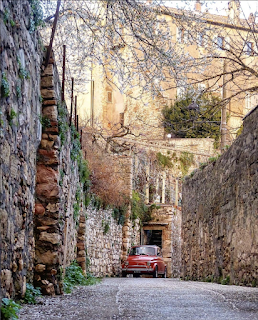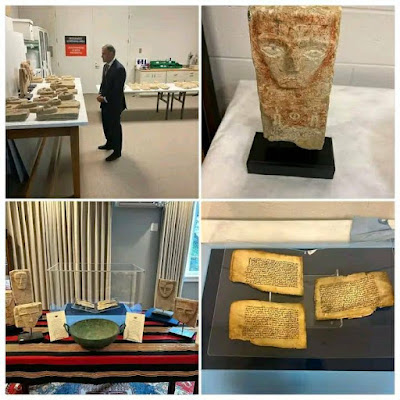 Biblioteca Marciana,book theft,Christopher Columbus,Cristoforo Colombo,Harlan Crow,Harlan Crow Library,incunabula,incunabulum,Martayan Lan,Massimo Messina De Caro,Richard Lan
Biblioteca Marciana,book theft,Christopher Columbus,Cristoforo Colombo,Harlan Crow,Harlan Crow Library,incunabula,incunabulum,Martayan Lan,Massimo Messina De Caro,Richard Lan
 No comments
No comments
Harlan Crow, the recently restituted Plannck I Columbus letter incunabulum
In mid July, those following restitution news might have read about the United States and Italian authorities happily announcing the restitution of a stolen 15th-century letter written by Christopher Columbus. Most of the many news articles which covered this particular restitution, were fairly pro forma. They focused on the historic significance of this precious incunabulum, written by the controversial Italian explorer in 1493 upon returning from his first voyage to the so called "New World". In his epistolary announcement, Columbus described his momentous journey to his royal patrons, King Ferdinand and Queen Isabella of Spain, who financed his expedition.
 |
| Portrait of Christopher Columbus By Ridolfo Ghirlandaio |
While the series of news articles discussed that the document had been stolen before 1988, from the Biblioteca Marciana in Venice, most were written in a perfunctory way, with many simply echoing the spartan details regarding the historical significance of this document, alongside the object's circulation as outlined in the US government's July 2023 announcement, ie., that the stolen document had been found in "the collection of a privately owned library located in the United States" after having been purchased via "a rare book dealer in the United States."
Why government press announcements on the restitution of historic artefacts can be rather "vanilla".
Normally the investigative agency announcing a restitution begins by describing why the painting or artefact is significant, and when and/or where it has been stolen. Press announcements then move on to state when, or sometimes how, the object in question has been identified, and then might, or might not, mention who the buyer or seller were. Usually at the conclusion of these briefs, the announcement wraps things up by thanking key individual investigators and the agencies involved, wrapping things up by naming all of the ceremonial VIPs who would have been present during the handover ceremony.
But as participants of ARCA's PG Certification Program in Art Crime and Cultural Heritage Protection learn during their studies with us. Sometimes these types of press statements leave us asking more questions than are answered. One question being, why are these announcements intentionally vague.
The writers of these briefings may choose to say less, as saying more might inadvertently impact other ongoing investigations. Other times, the agreed-upon press statement skims over the nominal information involving the handlers of the object for privacy considerations, or when the return is of a voluntary vs. criminal forfeiture.
Names can also be left out when the collector or museum who previously held ownership of the artefact or artwork has consented to its seizure and civil forfeiture, but has insisted on confidentiality provisions as part of their agreed-upon settlement whereby they relinquish all rights and titles. In tandem, sometimes these settlements can carry stipulations which clearly state that by relinquishing said object, doing so in no way should be deemed as an admission of culpability, liability, or guilt.
But what if you want to know more? And why we teach our researchers that OSINT gathering is a useful tradecraft, not reserved for the sneaky world of spies.
One of the things ARCA strives to impart to its art crime trainees is the need to explore and research beyond what seems obvious. To look beyond the low hanging fruit of a happy, but perfunctory, going home press release to what you might be able to find and interpret from unrelated sources. This is useful for provenance researchers as knowing more about an object's handlers can (sometime) tell us more about other artworks or artefacts which should also be explored.
To advance their provenance research skills, we teach our trainees how to conduct structured intelligence analysis, using a variety of techniques to efficiently gather and utilise the wealth of information readily accessible from disparate news sites, academic articles, blog posts, social media sites, search engine result pages (SERPs), and other public-facing digital assets. We do so because true OSINT is more than just taking a stab at scrolling-through the first page of ranked Google hits.
The European Commission defines open-source intelligence (OSINT) as the practice of collecting and analysing information gathered from open sources to produce actionable intelligence.
At ARCA we provide our participants with opportunities to test their abilities in practical and advanced image and video analysis and verification, as well as fact-checking and analysis of information, disinformation, and misinformation. These types of intelligence gathering can support, for example, national security, law enforcement investigations and even due diligence when vetting potential art and artefact purchases. At its very core, OSINT investigations look for open (source) data which was created for one purpose but when combined with other data, shed's additional or unforeseen light on otherwise hidden topics.
To illustrate how our researchers can glean more details on an object's circulation within the art, antiquities, and rare book market utilising only open source techniques, last month we had them start with the clues found in the July 18, 2023 U.S. Immigration and Customs Enforcement (ICE) announcement on the restitution of the Columbus letter titled Epistola de insulis nuper inventis, Rome, Stephan Plannck, after 29 April 1493, Goff C-757
I asked our researchers to explore a rudimentary hypothesis of whether this object's handlers might or might not be problematic art market actors and to back that up with their explorations. I also asked them to try and explore who the collector might be who discreetly relinquished the Columbus document, and was he (or she) of the ilk known to satisfactorily vet potential acquisitions such as this historic document.
We started by documenting the July 2023 HSI-ICE announcement which featuring Special Agent Mark Olexa, who served as the lead case agent in this ten+ year investigation into the thefts of several historic incunabula stolen from Italy.
His post appeared on Twitter on July 18th.
For over ten years, #HSI has collaborated with international partners to investigate a rare stolen 15th Century Christopher Columbus letter.
— Homeland Security Investigations (@HSI_HQ) July 18, 2023
On Wednesday, they return it to its rightful owners – the people of Italy. pic.twitter.com/j555wjeSnl
In this video we see footage of the what has come to be referred to as a Columbus Plannck I incunabulum, included the screen shot captured below. Pay attention to the annotations marked in red, as these will provide confirmations that we will come back to later.
We then looked for earlier mentions of any Columbus letter, 1493, Plannck I. Searching also for Plannck II, Cristoforo Colombo, rubata, Biblioteca Marciana, incunabolo, and so forth.
The key phrase being "in the house of a Dallas collector."




















